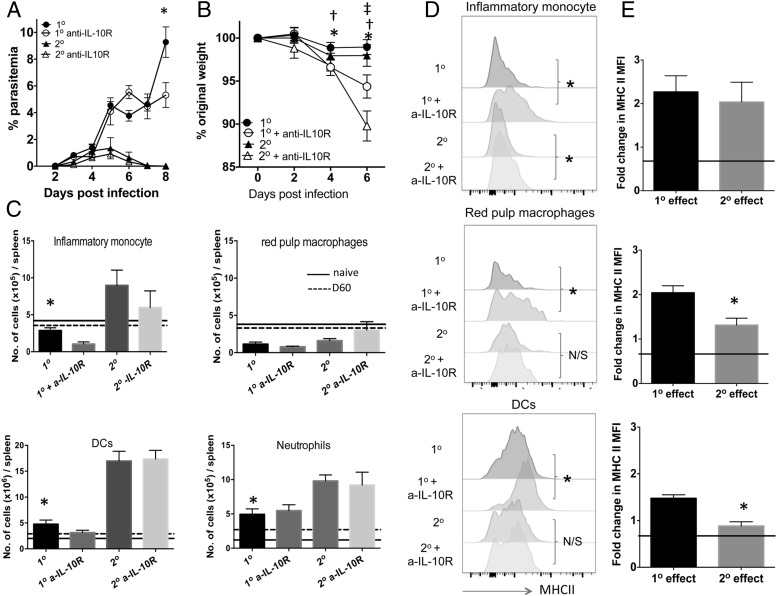FIGURE 6.
IL-10 exerts strong regulatory effects on the innate compartment during the early phases of primary infection. B6 mice were infected (i.v.) with 1 × 104 P. yoelii NL pRBCs or PBS. Mice were treated with pyrimethamine from day 9 postinfection for 10 d before being (re)infected (1 × 104 pRBCs [i.v.]) on day 60 postinfection with homologous P. yoelii NL parasites. Mice were injected with 250 μg of anti–IL-10R or PBS 1 d prior to (re)infection and on days 1, 3, and 5 after (re)infection. (A and B) The course of infection in anti–IL-10R-treated and control primary- and secondary-infected mice was monitored by assessing (A) peripheral parasite levels and (B) weight loss. (C) The effect of anti–IL-10R treatment on the numbers of splenic immune cell populations on day 4 during primary and secondary infections. (D) Representative histograms showing the effect of anti–IL-10R treatment on MHC II expression (mean fluorescence intensity [MFI]) by splenic innate cells on day 4 during primary and secondary infections. (E) Calculated relative effect of anti–IL-10R treatment on MHC II expression by splenic innate cells during primary and secondary infection (presented as fold change in MFI expression compared with expression in respective control-treated primary or secondary-infected mice). Level of no effect is reflected by solid line. (A, C, and E) The results are the mean ± SEM of the group with three to five mice per group and are representative of three independent experiments. (A) *p < 0.05 between primary infection versus anti– IL-10R-treated primary infection on annotated day. (B) *p < 0.05 between day 0 anti– IL-10R-treated primary infection versus anti–IL-10R-treated primary infection on indicated day, †p < 0.05 between day 0 anti–IL-10R-treated secondary infection versus anti–IL-10R-treated secondary infection on indicated day, ‡p < 0.05 between secondary infection versus anti–IL-10R-treated secondary infection on specified day. (A and B) Using two-way ANOVA test with a Bonferroni post hoc analysis. (C) *p < 0.05 between primary infected versus secondary infected, using one-way ANOVA test with a Bonferroni post hoc analysis. (E) *p < 0.05 between fold change in effect during primary versus during secondary infection. (D and E) Using a two-tailed unpaired t test.

